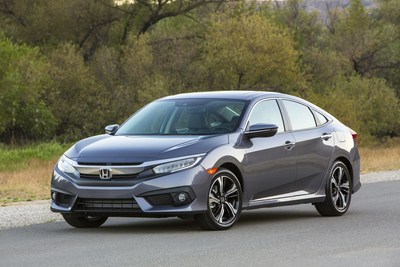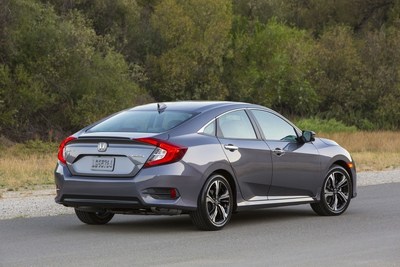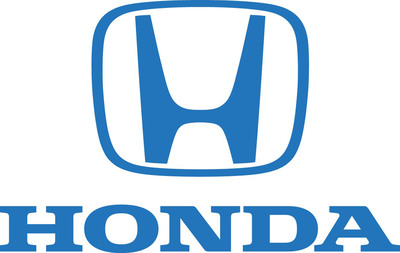All-new 2016 Honda Civic Sedan Adds IIHS TOP SAFETY PICK+ Collision Safety Rating to its List of Benchmark-Setting Features and Capabilities
– 2016 Civic Sedan joins 2016 Accord, CR-V and Pilot in achieving top IIHS safety ratings
– 2016 Civic Sedan sets new bar in mainstream compact class with Honda Sensing™ suite of advanced safety and driver-assist technologies available on all models
– 10th-Generation Civic also features next-generation Advanced Compatibility Engineering™ (ACE™) body structure
TORRANCE, California, Jan. 14, 2016 /PRNewswire-HISPANIC PR WIRE/ — The dynamic, new-from-the-ground-up 2016 Honda Civic Sedan, 2016’s North American Car of the Year, (www.automobiles.honda.com/civic-sedan/) has received the highest available rating of TOP SAFETY PICK+ from the Insurance Institute for Highway Safety (IIHS), including a SUPERIOR rating for frontal crash prevention when equipped with the Honda Sensing™ suite of safety and driver-assist technologies, available on all 2016 Civic Sedan models.

The 2016 Civic Sedan has earned a top rating of GOOD in five IIHS crash test modes, including the rigorous small overlap frontal crash test. The 2015 TOP SAFETY PICK+ designation is reserved for vehicles that also have an available front crash prevention system that earns an ADVANCED or SUPERIOR rating from the Institute.
“As these new safety ratings demonstrate, the 2016 Civic Sedan not only brings new value to the compact segment with its hefty upgrades to fun-to-drive performance, fuel efficiency, refinement and technology, it also delivers advanced collision safety performance,” said Jeff Conrad, senior vice president and general manager of the Honda Division. “With its available Honda Sensing technologies, including our first application of Adaptive Cruise Control with Low-Speed Follow, the new Civic Sedan offers customers a suite of technologies unlike anything else in the class.”
The 10th-generation Civic Sedan offers a wide range of advanced active and passive safety and driver-assist features and technologies, including Honda Sensing™, which is available on all trims. Honda Sensing™ technologies include:
- Collision Mitigation Braking System™ (CMBS™)[1]
- Forward Collision Warning (FCW) – integrated with CMBS[2]
- Lane Keeping Assist (LKAS)[3]
- Road Departure Mitigation (RDM)[4]
- Lane Departure Warning – integrated with RDM[5]
- Adaptive Cruise Control (ACC) with Low-Speed Follow[6]
Honda Sensing™ is available as a standalone option on LX, EX, EX-T and EX-L trims and is offered as standard equipment on the Touring trim.
The greater use of high-strength steel and advanced crash engineering features, including its next-generation Advanced Compatibility Engineering™ (ACE™) body structure, new crash stroke front frame structure and tailor-tempered B-pillars and rear frame structures, help better protect occupants in a collision while minimizing vehicle weight for superior fuel efficiency. In addition, standard passive safety features on the 2016 Civic Sedan include a new front passenger’s safety vent airbag, SmartVent® front side curtain airbags and side curtain airbags with rollover sensor.
All Civic Sedan models also come standard with Vehicle Stability Assist® with Traction Control, 4-channel Anti-Lock Braking System with Brake Assist; a highly responsive, fully independent suspension; Motion-Adaptive Electric Power Steering; a Multi-Angle Rearview Camera; Expanded View Driver’s Mirror; indirect tire pressure monitoring system; and Lower Anchors and Tethers for Children (LATCH) child seat mounting system.
The 2016 Civic Sedan is the first in a series of new 10th-generation Civic variants that will include a sedan, coupe, sports-minded Si models, a five-door hatchback and the first-ever Civic Type-R model for the U.S. market, comprising the most diverse and innovative lineup in Civic’s 43-year history. The new Civic Sedan’s design and development was led by Honda R&D Americas, and is manufactured by Honda of Canada Manufacturing in Alliston, Ontario and by Honda Manufacturing of Indiana in Greensburg, Indiana, using domestic and globally sourced parts.
About Honda Safety Leadership
Honda has a long history of leadership in the development and application of advanced technologies designed to enhance the safety of all road users, including automobile occupants, motorcycle riders and pedestrians. The company operates two of the world’s most sophisticated crash test facilities, in Ohio and Japan, and is responsible for numerous pioneering efforts in the areas of crashworthiness, airbag technology, collision compatibility and pedestrian safety.
Based in part on advancements to Honda’s Advanced Compatibility Engineering™ (ACE™) body structure, Honda is a leader in third-party crash test ratings within the industry. The company also is broadly applying advanced safety and driver-assistive technologies to its product lineup. All 2015 and newer Honda vehicles also come equipped with a rearview camera as standard equipment.
[1] CMBS cannot detect all objects ahead and may not detect a given object; accuracy will vary based on weather, speed and other factors. System operation affected by extreme interior heat. System designed to mitigate crash forces. Driver remains responsible for safely operating vehicle and avoiding collisions.
[2] FCW cannot detect all objects ahead and may not detect a given object; accuracy will vary based on weather, speed and other factors. System operation affected by extreme interior heat. FCW does not include a braking function. Driver remains responsible for safely operating vehicle and avoiding collisions.
[3] LKAS only assists the driver in maintaining proper lane position when lane markings are identified without a turn signal in use and can only apply mild steering torque to assist. LKAS may not detect all lane markings or lane departures; accuracy will vary based on weather, speed and road condition. System operation affected by extreme interior heat. Driver remains responsible for safely operating vehicle and avoiding collisions.
[4] Road Departure Mitigation only alerts drivers when lane drift is detected without a turn signal in use and can apply mild steering torque to assist driver in maintaining proper lane position and/or brake pressure to slow the vehicle’s departure from a detected lane. Road Departure Mitigation may not detect all lane markings or lane departures; accuracy will vary based on weather, speed and road condition. System operation affected by extreme interior heat. Driver remains responsible for safely operating vehicle and avoiding collisions.
[5] LDW only alerts drivers when lane drift is detected without a turn signal in use. LDW may not detect all lane markings or lane departures; accuracy will vary based on weather, speed and road condition. System operation affected by extreme interior heat. Driver remains responsible for safely operating vehicle and avoiding collisions.
[6] Adaptive Cruise Control (ACC) with low-speed follow cannot detect all objects ahead and may not detect a given object; accuracy will vary based on weather, speed and other factors. ACC should not be used in heavy traffic, poor weather or on winding roads. Driver remains responsible for safely operating vehicle and avoiding collisions.


Photo – http://photos.prnewswire.com/prnh/20160113/322063






